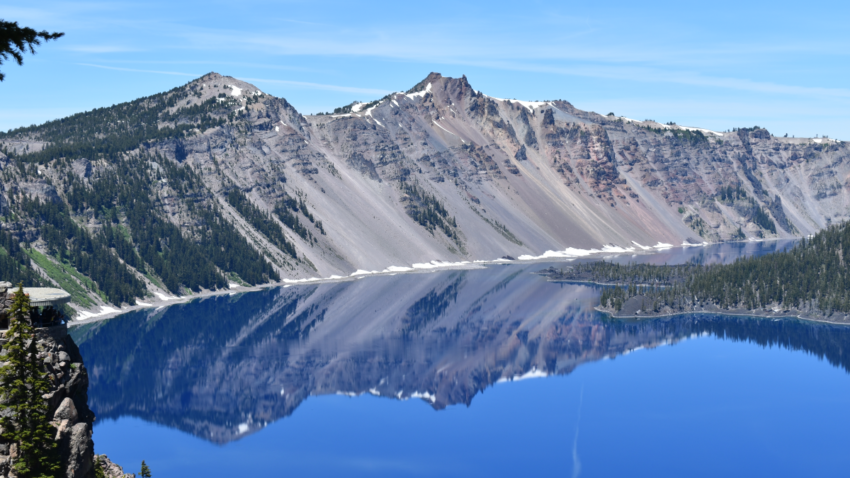When you’re trying to visit as many national parks and monuments as possible, you tend to group them by region to save time. I suppose that’s how I happened to find myself unintentionally visiting four parks highlighting North America’s volcanic history in just a week this summer.
The first stop on journey was Craters of the Moon National Monument in Idaho. Due to its fairly remote location, it’s a place most visitors make an intentional effort to reach — including Apollo program astronauts, who later found that the real moon is actually different from Idaho.
To me, the Inferno Cone offered the closest thing to what you might think of as a “moon” experience. The surface is a blacktop-like oily gravel with some vegetation peeking out in the areas less travelled by us tourists (there is no official trail up the cone).



Hikes to the Big Craters and the Tree Molds also provide more moon-like experiences in spots, with views looking out over craters and massive lava fields.
The next stop on the journey was Crater Lake National Park in Oregon. The stunning blue lake formed when a massive volcano collapsed in an event likely witnessed by Native Americans.
At Crater Lake, all you need to do is stop and stare. It’s one of the most impressive sites I’ve ever seen.

There’s no need to walk more than a few feet from your car to gaze at the wonder that is the lake, but a hike along the Discovery Trail from the Rim Visitor Center is a great way to continue staring at the lake from multiple angles. I had two full days to spend at Crater Lake and spent most of my time driving the scenic road around the lake and staring at it from multiple angles. Totally worth it.



The summer season at Crater Lake is short (it receives more snow than any place in Oregon). By the time of my trip in early July, East Rim Drive still hadn’t fully opened and the boat tour was not yet running. Something to keep in mind for future vacation plans.

Crater Lake is a popular place and I couldn’t get a campsite in the park, but I did luck out with a site at the nearby Union Creek Campground in Rogue River National Forest. By chance, site #41 was the only one available when I booked, and other campers agreed that its view of the creek probably makes it the best one in the campground!
There are also some cool nearby geologic viewpoints on the Rogue River, which I didn’t know about until I got there.
Next on the journey, it was time to enter California for the third time this year. After assuring the border inspector that I didn’t have any fresh produce, I made a brief stop by Tulelake National Monument (an important site but not a lot to see unless you’re there on a tour day) before continuing to Lava Beds National Monument.

Lava Beds offers a view of several kinds of volcanoes including one you don’t hear much about, a shield volcano. That’s the kind where the volcano is relatively flat and leaves a long field of lava. To me, it kind of looked like a million blacktop trucks all dumped their loads in a field — in a cool way.
There is also a short hike to Black Crater, which is small but cool, and another hike to a lookout tower that I didn’t take because of the hot weather. The park also protects important Native American cultural sites.
Despite being named “Lava Beds,” the park’s main attraction actually seemed to be its caves. Due to concerns about white nose syndrome, they don’t want you to go in the caves if you have anything (even a phone or camera) that you have ever taken into another cave. Having been at Lehman Caves a month earlier, I didn’t go into the caves here.
The journey south from Lava Beds to my final volcanic destination, Lassen Volcanic National Park, involved a lot of turns on remote highways, but I still somehow managed to find myself stuck behind hay trucks a half-dozen times!
Lassen became a national park with it when it started erupting in 1915. Driving south on the park scenic road, the views get more spectacular as the road rises and ultimately reaches spectacular mountain lakes. Nearby is the trailhead for Bumpass Hell Trail. Despite its name, it turned out to be one of the best hikes I’ve ever had!


The trail takes you to a field of volcanic features that feels (and smells) like a miniature version of Yellowstone. It’s named for a guy who lost his leg when he stepped in the wrong spot. Fortunately, there’s a boardwalk now.
I found that the trail to hell was actually pretty heavenly, with massive views of the mountainous area as you walk along the cliff.
This journey would be great for a kid who’s interested in volcanoes, but it was also great for an adult who still has plenty to learn — and was looking for some peaceful spots!

